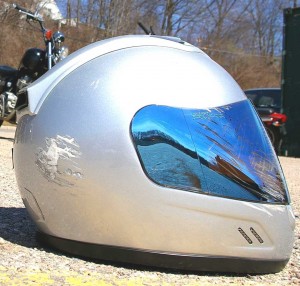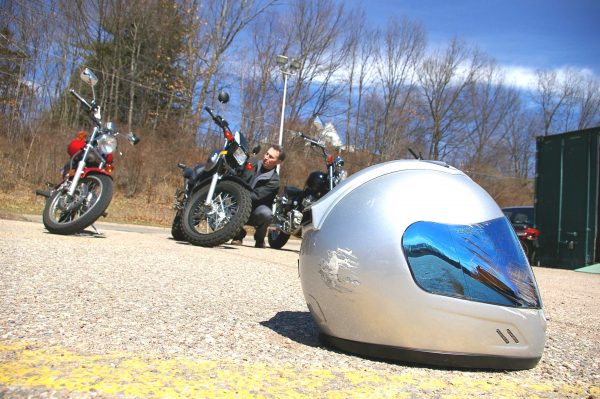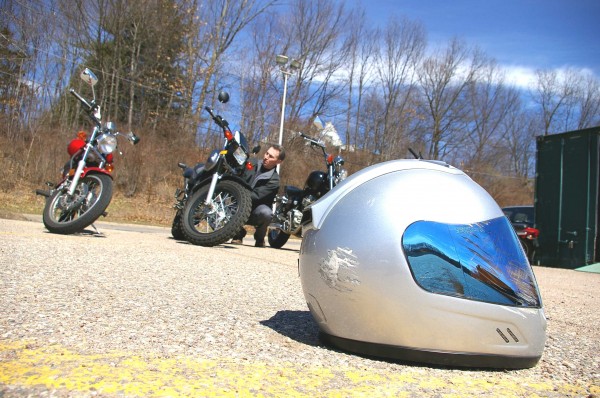Is it time to replace your helmet? Has it been dropped? Is it more than five years old? Or, perhaps, are the generally accepted rules for replacement a bunch of baloney?
A new survey out of the U.K. suggests that many riders there are wearing helmets that are too old. The Carole Nash insurance company did the survey and found that 40 percent of riders are wearing lids that are more than five years old. And 63 percent of the 1,006 riders surveyed admitted to wearing a lid that had been dropped.
the survey and found that 40 percent of riders are wearing lids that are more than five years old. And 63 percent of the 1,006 riders surveyed admitted to wearing a lid that had been dropped.
The website Visordown on Friday quoted a Carole Nash spokesperson as saying “63% of riders are currently at risk of increasing the likelihood of brain damage in the event of an accident” because they wear a helmet that has been dropped.
The spokesperson continued, “One of the golden rules of owning a helmet is a simple one – if you drop it, bin it. Helmets are complex products and are designed to behave in certain ways when placed under stress – so even if you’ve dropped yours from the lowest height imaginable, it’s not worth risking it on the road.
“Another useful hint for bikers is to replace your helmet once every five years. Like most things on earth, helmets aren’t immortal – so if, like 40% of riders here in the UK , your helmet is over five years old, it’s definitely time to start flicking through some catalogs and pricing up a new lid.”
Have you priced a helmet lately? A name brand helmet can cost $400 to $800. Sure, only someone with a $5 brain would would wear a $5 helmet, but are the generally accepted rules regarding helmets – replace if dropped, replace after five years – really valid?
Many of the readers who responded to the Visordown story questioned them, suggesting manufacturers’ desires for extra sales and fears of lawsuits were the real reasons for the “rules.”
A reader going by the name of Cafe Ray supplied a link to the Snell Memorial Foundation, which certifies helmets. It revealed that dropping a helmet doesn’t mean it must immediately be replaced:
“Generally the answer is probably not,” Snell reported. “Helmets are one-use items, but are quite durable otherwise, at least the  ones we certify. Frequent dropping or spiking a helmet on the ground, or other hard surfaces may eventually degrade the helmet’s performance. Similarly if the helmet falls to the ground at highway speeds unoccupied, the owner must be aware that some degradation may have occurred. In general, the real damage comes when the helmet contacts an object with a head inside.”
ones we certify. Frequent dropping or spiking a helmet on the ground, or other hard surfaces may eventually degrade the helmet’s performance. Similarly if the helmet falls to the ground at highway speeds unoccupied, the owner must be aware that some degradation may have occurred. In general, the real damage comes when the helmet contacts an object with a head inside.”
And what about the five-year “rule” for replacement? Snell said, “The five-year replacement recommendation is based on a consensus by both helmet manufacturers and the Snell Foundation. Glues, resins and other materials used in helmet production can affect liner materials. Hair oils, body fluids and cosmetics, as well as normal ‘wear and tear’ all contribute to helmet degradation. Petroleum based products present in cleaners, paints, fuels and other commonly encountered materials may also degrade materials used in many helmets possibly degrading performance.
“Additionally, experience indicates there will be a noticeable improvement in the protective characteristic of helmets over a five-year period due to advances in materials, designs, production methods and the standards. Thus, the recommendation for five-year helmet replacement is a judgment call stemming from a prudent safety philosophy.”
Guess that means that if you’ve treated your helmet with care, you can forget the “rule.”
Meanwhile, the forensic investigations firm MEA Forensic reports that the “scientific basis (for replacement every two to 10 years) is unclear, and a cynical consumer might view the short end of this range as self-serving for helmet manufacturers.”
On the subject of dropped helmets, MEA Forensic states, “Few published studies have evaluated the effect of age on helmet impact performance. Previous tests we did showed that unused 10-year-old motorcycle helmets attenuated impacts as well as new helmets.”
So, there’s some food for thought.
The insurance company did also say that 38 percent of U.K. riders use a black helmet and recommended the use of “fluorescent yellow” ones instead.
 Ride CT & Ride New England Serving New England, NYC and The Hudson Valley!
Ride CT & Ride New England Serving New England, NYC and The Hudson Valley!



